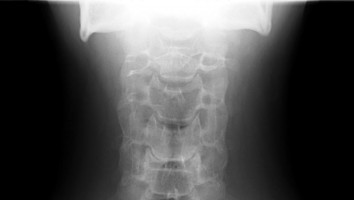
A radioactive bone cement that's injected into bone to provide support and local irradiation is proving to be a safer alternative to conventional radiation therapy for bone tumours, according to a study led by University of California, Irvine researchers.
The study shows that this brachytherapy cement can be placed into spinal bones to directly irradiate tumours without harming the spinal cord, and the radioactive material will stay localised in the bones, which promises to virtually eliminate side effects.
Lead researcher Joyce Keyak, UCI professor of radiological sciences, presented the results at the 2021 annual meeting of the Orthopaedic Research Society, which was held virtually Feb. 12-16.
Cancers that begin in the breast, prostate, lung, thyroid, kidney and other locations can spread to and erode bones, most commonly in the spine.
Further complicating matters, normal radiation treatments for this problem can threaten the spinal cord and weaken the bones already compromised by the tumour's erosion, increasing the risk of fracture.
Currently, multiple sessions of external beam radiation are used to treat cancer that has spread to the spine.
This radiation causes unpleasant side effects (nausea, vomiting and diarrhoea) and passes through the spinal cord, which often delays and limits treatment.
"Brachytherapy cement could be used without delay in a convenient, one-step, minimally invasive treatment to irradiate tumours," Keyak said, "and would not irradiate the spinal cord or limit future treatment options."
In animal and computational studies, the researchers evaluated the short-term safety of injecting brachytherapy cement into vertebrae; the possible migration of radioactivity into blood, urine or faeces; the dose rate outside the injection site; and the radiation dose from phosphorus-32 emissions to the spinal cord and soft tissue.
At 17 weeks post-injection, physical examinations were all normal and no activity was detected in blood, urine or faeces.
The researchers found no evidence of the P-32 isotope in the circulating blood, no changes in blood work related to radioactivity and no neurological deficits.
"This localised treatment for bone tumours stays localised, and we did not see any effects outside the bone," Keyak said. "This is important because traditional radiation therapy causes adverse effects such as nausea, vomiting and diarrhoea."
Keyak and Dr. Harry Skinner, an orthopaedic surgeon with St. Jude Heritage Medical Group, created the brachytherapy cement by infusing a common product of their trade, bone cement, with radioactive material already used in other treatments.
The brachytherapy bone cement does not have the same side effects as traditional radiation therapy, Keyak noted, because the injection directly targets the tumour and radiation doesn't pass through other organs, such as the intestines or stomach.
Previous studies also revealed that it can immediately reduce pain in the spine, potentially getting patients off strong painkillers that could carry additional side effects.
Normally, a bone cancer patient needs 10 or more sessions of radiation therapy.
But with the brachytherapy bone cement, Keyak said, a single injection can provide an equivalent, targeted tumour treatment with significantly less threat to the spinal cord and nerves.
"You can have this procedure and be done with it," she said. "And you can do it when tumours are smaller to prevent further bone and spinal cord damage, while limiting the pain and side effects that patients often feel."
Keyak and Skinner have started a company, Bone-Rad Therapeutics, for their product and have licensed its intellectual property (four patents and one pending patent).
The next step, Keyak said, will be more animal studies, followed by an application for a clinical trial.
We are an independent charity and are not backed by a large company or society. We raise every penny ourselves to improve the standards of cancer care through education. You can help us continue our work to address inequalities in cancer care by making a donation.
Any donation, however small, contributes directly towards the costs of creating and sharing free oncology education.
Together we can get better outcomes for patients by tackling global inequalities in access to the results of cancer research.
Thank you for your support.